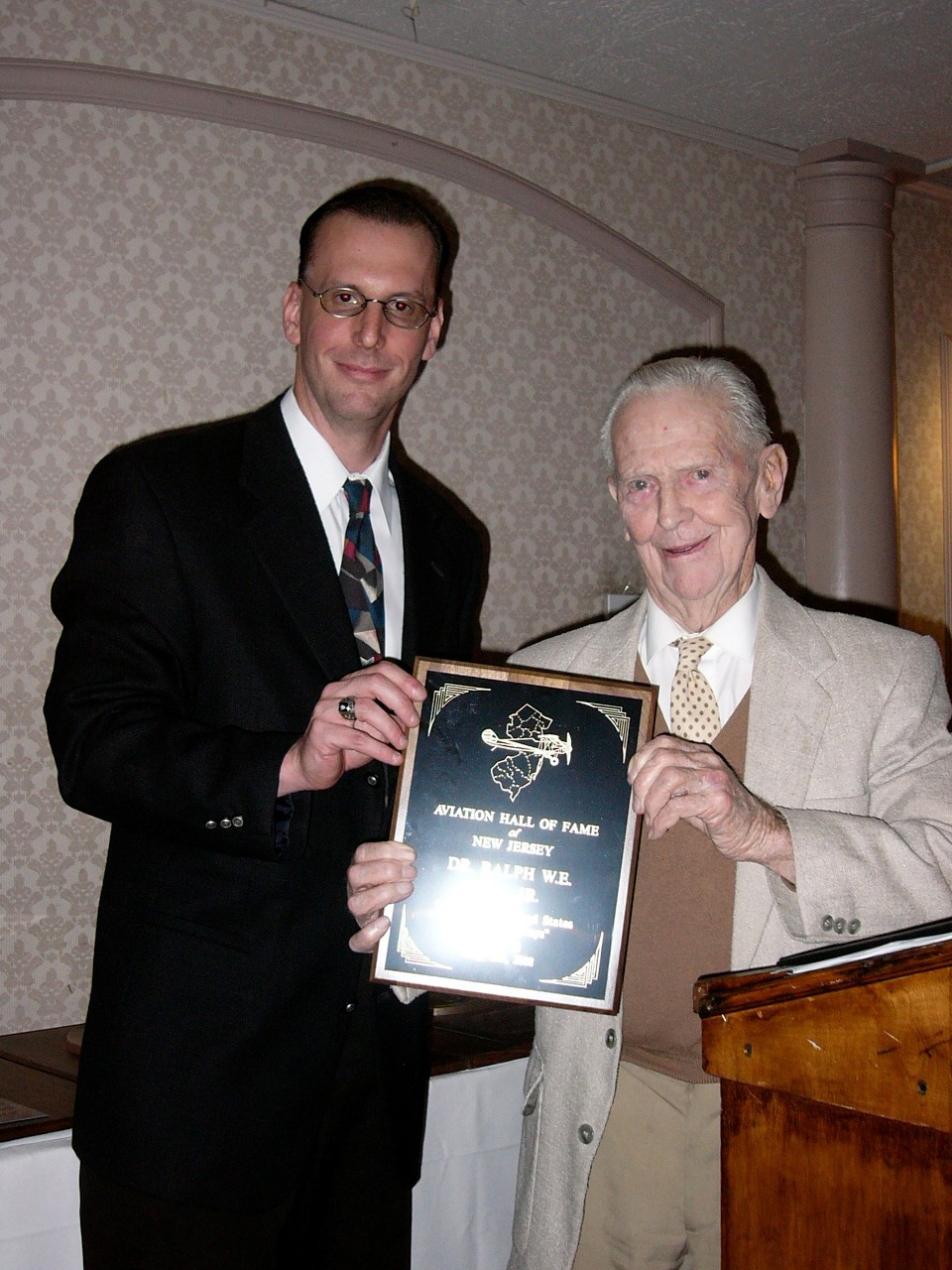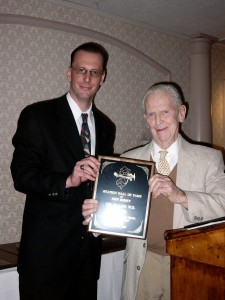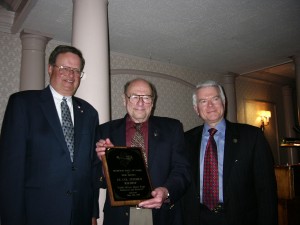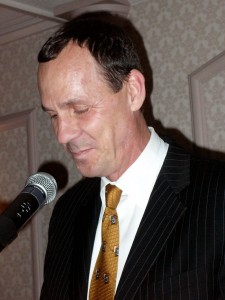By Jack Elliott
On May 21, four individuals were inducted into the New Jersey Aviation Hall of Fame at the 35th annual induction dinner, held at the Fiesta Ballroom near Teterboro Airport. This year’s inductees were Dr. Ralph W.E. Cox Jr., John Kenneth Forester, George Mennen and Lt. Col. Stephen F. Riethof.
Cox was the founder of United States Overseas Airlines, at one time the second largest supplemental airline in the U.S. The airline, founded in 1959, operated 41 aircraft. During its 14 years of operations, USOA accrued three billion passenger miles without a fatality. Based at Cape May County Airport in Wildwood, N.J., USOA was the first airline founded in the state. It participated in the Korean Airlift (1950-53), the DEW line construction and servicing (1955-57) and in President Truman’s Point Four aerial locust eradication program in the Middle East, for which Cox received a personal commendation from the president. A dentist by profession, he gave up that career in 1939 to fly PBYs for the Navy. During WWII, he flew Sikorsky VS-44s and other flying boats of American Export Airlines.
Forester’s aviation career began in 1941, when he got his pilot’s license at the age of 18. The following year, he joined the U.S. Army Air Corps, and from 1944 to 1948, was a test pilot, flying fighters, bombers and transport aircraft. He flew the nation’s first jet, the Bell Airacomet P-59, and the first operational jet fighter, the Lockheed P-80 Shooting Star. He attained a mechanic’s license while in the military, and after discharge in 1946, founded Mallard Air Service at Teterboro Airport. Mallard was a distributor for the Republic Seabee and the North American Navion and was a maintenance base and charter operator. Mallard later converted C-47s from military to civilian aircraft. Forester started the General Aviation Company in the mid-1950s. In 1986, it became a Millionaire franchise. Today, it operates as an independent charter company, under the name Meridian Aircraft.

L to R: Dennis Miskewicz, dinner chairman; inductee John Kenneth Forester; and Stephen F. Riethof, associate director of AHOF.
Mennen, former chairman of the Mennen Company, loved to fly and enjoyed talking flying to people who hung around the airport. He learned to fly at Morristown Airport, and in the ’50s and ’60s, was part owner of the airport’s FBO, Chatham Aviation. He owned a Spartan Executive, a rare aircraft that was perhaps 30 years ahead of its time. A number of petroleum executives owned the aircraft, along with a Middle Eastern head of state. Only 34 of the aircraft were built and Mennen owned number 34. He used his Spartan, which could cruise at speeds in excess of 200 mph, to transport company officials to distant facilities. He eventually donated the aircraft to the Experimental Aircraft Association’s museum in Oshkosh. It’s currently based at the EAA’s Pioneer Airport.
Riethof served in the Air Force for 29 years. He entered the flight-training program immediately after graduating from college in 1952 and served in the Air Defense Command as a weapons systems officer. After active service, he joined the New York Air National Guard at Westchester County and flew missions in F-93Bs, and later flew tactical radar assignments. He became the only reserve officer to become a fully qualified senior director in the largest air defense sector of NORAD. He received two National Air Defense Service Medals and the Meritorious Service Medal. He retired from the service in 1981. Riethof currently serves as vice president of the New Jersey Aviation Hall of Fame and Museum. An independent flight instructor, he’s been named certificated flight instructor of the year three times by the FAA Eastern Region and has qualified three times as a master flight instructor. He also serves as an FAA safety counselor and as the Aircraft Owners and Pilots Association’s airport support network representative for TEB. He’s been active in the AHOF as a volunteer and member of the board of trustees for many years.

Attorney Will Mennen, left, accepted the inductee plaque on behalf of his late grandfather, George Mennen.
Two special awards were presented. The Distinguished Service Plaque was awarded to Fritz Rethage, editor and publisher of the Gazette, a newspaper that circulates in five towns surrounding Teterboro Airport. Through his newspaper, Rethage has been an ardent supporter of TEB for a number of years. The Fred L. Wehran Achievement Award was presented to AvPORTS, current operator of Teterboro Airport. Carol Greene, daughter of Fred Wehran, who owned and developed Teterboro Airport after WWII, presented the award.
Keynote speech
Robert A. Sturgell, Federal Aviation Administration acting administrator, gave the keynote address. He reminded the audience that this was the 50th anniversary of the FAA and invoked them “not to forget to celebrate what we do safely and successfully each and every day.”
“On a typical day, the FAA moves 52,000 airplanes, and the millions of people in them, without a hitch,” he said. “Yes, the agency has its shortcomings, and we’re fixing them. It’s good that we keep a sharp focus on our mistakes.”Equally impressive, the airlines are posting the fewest accidents since 1994—and nearly all of those were minor.
“On the GA side, which historically has been a problem area, we’ve had the fewest fatal accidents and fatalities since World War II,” Sturgell said.
He attributed the improved safety records, in large part, to two technological advances: the jet engine and radar. He pointed out that in 1953, piston engine failures were a major problem. Twin-engine, and even three-engine aircraft, weren’t allowed to fly routes more than an hour from an airport.
“The reliability of jet engines changed that,” he said.
Prior to radar, Sturgell pointed out, pilots had to wait hours for complex computations done by hand and often based on outdated information provided by other pilots.
“Radar changed the rules,” he said. “It gave us greater airspace efficiency and improved safety. By being able to independently identify location and heading, you lower the odds of a midair collision, as well as other risks, like getting lost or flying to the wrong airport. Looking back, the safety advances over the last 50 years are nothing short of amazing. But what about the next 50?”
He said a system currently under development to make the skies even safer is the Automatic Dependent Surveillance-Broadcast, which is based on satellite technology. It puts pilots and controllers on the same page, so pilots can see what the controllers see, and supports airport surface safety.
Two other recent advancements are Traffic Alert and Collision Avoidance System Enhanced Ground Proximity Warning System, which warn pilots if their flight paths are in conflict with approaching terrain or obstacles.
Flight technology is improving; Sturgell pointed out that each generation of new jets has reduced accidents by a third. Coming into the system are new aircraft, such as the Boeing 737 and 777 and Airbus’s A320. The new generation Boeing 787 and Airbus A380 will take safety another step forward.
“Our redesign plans reflect the fact that the air space is a finite resource,” he said. “It’s just making more efficient use of that resource, so we can provide better service to you, the users. Thus far, our initial results are showing promising results.”
Sturgell also reflected an acute awareness that runways are a significant part of air system problems. He indicated that the FAA was taking action to alleviate that problem.
“Over the last decade, we’ve poured concrete at 13 new runways at some of our busiest airports,” he said. “They include one at Logan, which opened in 2006, and one at LAX, which opened for business in March 2007. We’re adding three more runways later this year at SeaTac, O’Hare and Dulles. They should be up and ready by November.”
Projects are currently in the works at eight major airports, running through 2012. Those projects will provide the potential to accommodate 400,000 more operations. At the same time capacity is being increased, delays will be decreased by almost two minutes per operation.
“Today’s operations and tomorrow’s challenges; that’s what’s occupying me and the 43,999 others who proudly wear the badge of the FAA,” Sturgell said. “We’re constantly looking for ways to do our jobs better: to make the airspace safer and more efficient today than it was yesterday.”














